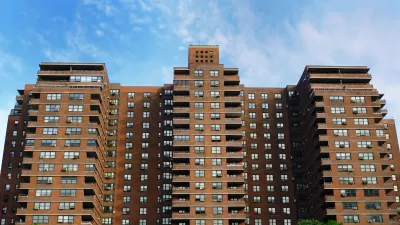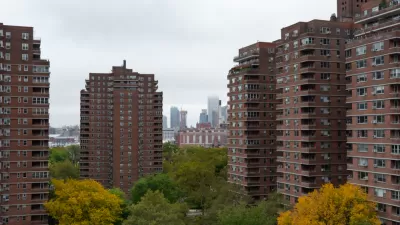Conventional planning think says that mixed-income development benefits low-income neighborhoods. But a survey finds that residents of public housing in New York don't agree—rather, they feel left behind by newcomers to the neighborhood.
Greg B. Smith reports on a study by Abt Associates and New York University's Furman Center for Real Estate, commissioned by the city of New York, about the impacts of gentrification on residents of New York City Housing Authority buildings. According to Smith, the report "reached a conclusion most New Yorkers already accept as true: gentrification doesn't help the poor."
"The study, 'The Effects of Neighborhood Change on NYCHA Residents' [pdf]…found that NYCHA tenants often wind up feeling like aliens in their own neighborhoods, surrounded by newcomers who claimed they'd just 'discovered' the neighborhood."
The study, released in May, runs counter to the narrative about the benefits of developing new mixed-income housing in low-income neighborhoods. During the same month, the de Blasio Administration announced "a controversial plan to build hundreds of market-rate apartments on 'underutilized' NYCHA property," according to Smith.
NYCHA spokesperson Aja Worthy-Davis noticed the difference, releasing this statement about the goals of the proposal to build more units on NYCHA properties: "By building both affordable and mixed-income housing, we will protect NYCHA housing, expand affordable housing options for everyday New Yorkers, and bring small businesses and services like supermarkets and restaurants closer to NYCHA developments….We will in turn use this growth to connect NYCHA residents to new employment opportunities."
The article includes a lot more detail about the study and its implications for New York and on the debate about investment in low-income neighborhoods.
FULL STORY: EXCLUSIVE: NYCHA residents see little benefit from gentrification in their neighborhoods, report shows

Planetizen Federal Action Tracker
A weekly monitor of how Trump’s orders and actions are impacting planners and planning in America.

San Francisco's School District Spent $105M To Build Affordable Housing for Teachers — And That's Just the Beginning
SFUSD joins a growing list of school districts using their land holdings to address housing affordability challenges faced by their own employees.

The Tiny, Adorable $7,000 Car Turning Japan Onto EVs
The single seat Mibot charges from a regular plug as quickly as an iPad, and is about half the price of an average EV.

Seattle's Plan for Adopting Driverless Cars
Equity, safety, accessibility and affordability are front of mind as the city prepares for robotaxis and other autonomous vehicles.

As Trump Phases Out FEMA, Is It Time to Flee the Floodplains?
With less federal funding available for disaster relief efforts, the need to relocate at-risk communities is more urgent than ever.

With Protected Lanes, 460% More People Commute by Bike
For those needing more ammo, more data proving what we already knew is here.
Urban Design for Planners 1: Software Tools
This six-course series explores essential urban design concepts using open source software and equips planners with the tools they need to participate fully in the urban design process.
Planning for Universal Design
Learn the tools for implementing Universal Design in planning regulations.
Smith Gee Studio
City of Charlotte
City of Camden Redevelopment Agency
City of Astoria
Transportation Research & Education Center (TREC) at Portland State University
US High Speed Rail Association
City of Camden Redevelopment Agency
Municipality of Princeton (NJ)




























